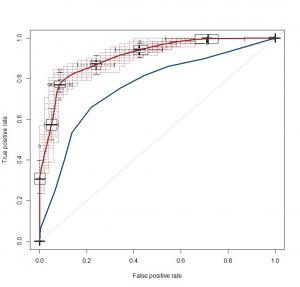Overview
Early and aggressive fluid resuscitation in shock is associated with improved patient outcome and mortality. However, there is a clear correlation between cumulative fluid balance and mortality. There is, therefore, a benefit to adopting a systematic approach to fluid resuscitation to determine which patients would benefit from a fluid bolus with increased stroke volume to avoid risks associated with volume overload.
Multiple methods have been proposed to predict increase stroke volume with fluid bolus. None of the current techniques have demonstrated positive relationships or involve invasive procedures and have the potential for serious complications. Point-of-care ultrasound (POCUS) is an attractive option to assess volume status and predict fluid responsiveness. However, currently, POCUS systems are complex, required skilled practitioners and do not provide data in a format designed to guide real-time clinical decision-making. UMB researchers have described a proprietary algorithm that allows the healthcare provider to use ultrasound to more efficiently and accurately predict if cardiac stroke volume (SV) will increase with fluid bolus. The proprietary technology is called combination arterio-venous sonography (CAVS).
The CAVS algorithm uses several measurements that can be readily obtained by POCUS to estimate SV. The algorithm was derived from The Volume Responsiveness Study that was an observational study of 138 patients receiving a fluid bolus. Patients who responded with an increase in SV were identified (+SV). The ability of the algorithm to predict the +SV patients from the study was analyzed using statistical analysis (Receiver Operating Characteristics (ROC)). The training receiver operating curve (ROC) showed that the algorithm ability to accurately predict (identify) +SV was excellent at 0.90 (p <0.0001). ROC of 1.0 represents a 100% sensitivity and 100% specificity for the algorithm. The model performed incredibly well in validation testing, maintaining and ROC of 0.77 (p <0.0001). The results of this work have been accepted for publication in The Journal of Trauma and Acute Care Surgery.

Applications
POCUS is a $700 million dollar market with a 7-8% annual growth rate. Currently, there are no other significant applications designed to assist in using POCUS to direct care of critically ill patients. Widespread adoption of POCUS to make critical treatment decisions is limited by the skill of individual practitioner at evaluating POCUS images and by the fact that the assessment is subjective. The utility of the POCUS is limited by lack of software for quantification, diagnosis support, and clinical decision-making. The POCUS market is expanding despite these limitations, as units are very portable, relatively inexpensive, and the procedures can be performed quickly. CAVS addresses this need for better measures of ultrasound data analysis and intravascular volume status. Its impact can also be expanded to areas with reduced resources, such as the developing world and military settings, where hemodynamic monitors are not common or feasible.
Advantages
Improves use of point-of-care ultrasound for patient treatment
Predicts which critical patients will respond positively to a fluid bolus
Stage of Development
This technology has been tested in a clinically relevant heterogeneous population of critically ill surgical patients.
Licensing Potential
Available for licensing and commercial development
Contact Info
Office of Technology Transfer
620 W Lexington St., 4th Floor
Baltimore, MD 21201
Email: [email protected]
Phone: (410) 706-2380